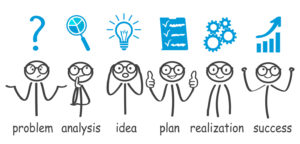Problem solving skills are highly valued in the workplace. There is no shortage of problems to be solved, from small problems to big problems and everything in ![]() between. Many people are good at finding problems but not as many want to put the time and effort into solving them. If you are a manager who wants to increase your value and make yourself more
between. Many people are good at finding problems but not as many want to put the time and effort into solving them. If you are a manager who wants to increase your value and make yourself more ![]() promotable, get good at problem solving.
promotable, get good at problem solving.
What is Effective Problem Solving

Effective problem solving means solving the right problem. This requires a certain degree of skill. A lot of people know how to make snap decisions without getting all the facts and they end up solving the wrong problem resulting in wasted time, energy, and effort. This is not an admirable trait and will not help you get promoted. How do you know if you’re solving the right problem?
Solve the right problems
Problems that are worth solving are the ones that affect cost, time, quality, and productivity.
Examples include:
- Gaps in processes that result in late payments, redundancies, and miscommunications. Are your procedures current? Do you have procedures? Lack of procedures is the cause for most problems.
- Automating manual processes to improve productivity and reduce the amount of staff needed. This is especially important in the current environment of record-low unemployment when employers are having a hard time filling open positions.
- Lack of standards. According to Gallup, 50% of employees don’t know what’s expected of them at work. The first question a manager should ask when problem solving is, ‘Have I communicated job expectations to my staff?’ If your answer is no and you don’t know how to begin, Communicate Like a Boss will walk through the steps.
Get the facts! Don’t waste time solving a problem that affects a tiny percent of output, processes, or customers. This is a huge mistake that many managers make. They hear about a problem and set out to fix it without realizing the impact was minimal to begin with. To avoid focusing on the trivial few, as Stephen Covey warned in the classic 7 Habits of Highly Effective People, gather the facts and assess the impact.
Only after you have determined you have a problem worth solving is it time to get into solution mode. Coming up with a wide-range of solutions requires creativity, an open mind, and input from others. There are many ways to come up with ideas and the most important thing to remembers is that you want a lot to choose from so don’t stifle creativity.
Decision-making factors
After you have a variety of solutions to choose from, decide what criteria will be used for decision-making. 3 common decision-making factors are: Time, Cost, and User Satisfaction.
- Time to implement. How much time will it take to implement the solution? A solution that takes 6 months to implement isn’t ideal if the problem affects customers. Problems worth solving typically rank high in time to implement. Think about it, a problem that affects quality, quantity, or time will affect the bottom line and therefore requires a faster turn-around time.
- Cost to implement. You may decide to go with a low-cost solution for a temporary fix while you work out a better long-range solution. Duct tape is really cheap but may not be the best long-term solution. The threshold of my front door is currently being held down by duct tape. Let me tell you, this is not an ideal solution and I really hope my husband is working on a long-term solution to the problem. However, it works for now. Have you budgeted for unexpected issues or will the problem have to wait until the next budget cycle? Anticipate the unexpected and add a line item for contingencies or process improvements.
- User satisfaction. Whether the end-user is the staff or the customer, consider how happy they will be with the solution. Implementing a solution that requires more work for the staff is not ideal and will rank low. There is always a way to find a better way that requires less steps. A solution that removes options for customers is not ideal either.
Case in Point: An organization was working on a solution to deal with unpaid customer invoices. Instead of solving the real problem – no internal process for collecting payments – a decision was made that limited the ways in which customers could pay. In effect, 98% of the customers will be negatively impacted because there isn’t an internal process to follow up with the 2% of customers who don’t pay on time.
Work smarter, not harder
You’ve probably heard this mantra before. Use this as the final guide for all your problem-solving decisions. Any solution you implement should improve quality, quantity, or time without creating more work or a negative customer experience. As a final check, if the solution increases time or effort or negatively affects the end user, go back to the drawing board and make sure that 1) you are solving the right problem, and 2) you have considered a wide-range of solutions.
If you want to increase your value to the company and make yourself more promotable, improve your problem solving skills. Constantly be on the lookout for ways to make processes faster, better, and easier and both you and your team will go far.
Liz Uram is a nationally-recognized speaker, trainer, consultant, and author. She is known as the Queen of Ops for her ability to she through chaos and confusion to get results better, faster, and cheaper. Watch: Problem Solving with the Queen of Ops
